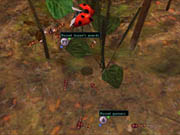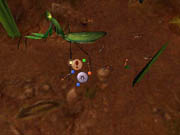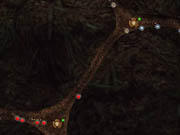If you think ants are just annoying, stupid pests that invade your cookie jar or bite your feet in the backyard, think again. They're actually an enormously sophisticated group of creatures, and they form the subject of Empire of the Ants, a real-time strategy game from developer Microïds. Empire of the Ants was inspired by the international best-selling novel of the same name, written by French science journalist Bernard Werber. One of the novel's primary plot strands centers on the russet ant empire of Bel-o-kan, which you'll lead to supremacy while gathering resources and fighting enemy insects. If only the game were as interesting as its subject matter, it would have a lot to offer. As it stands, it's generally dull, unfriendly, and buggy (no pun intended).

As odd as it might sound to make a real-time strategy game about ants, the subject matter has intriguing game design possibilities. Ant colonies have complex social structures with multiple castes working in close cooperation, and their huge nests can serve as home to 10 million members. They can build structures from leaves they shred and then bind together in new forms. They communicate with each other by tapping, emitting squeaks or buzzes, or using chemical pheromone markers. Ants regularly take other ants and insect species captive and use them as a specialized slave labor force. Other than humans, ants are also the only species to regularly engage in highly organized mass warfare. They even resort to chemical warfare, thanks to some species' ability to spray poison or acid. Feuds between nearby colonies can go on for years and feature raids and vicious battles.
You'll experience a little--but not enough--of this strange, miniature world in the game. Your overall goal is simple: build and manage your colony so that it can survive and grow in the face of enemy ants, predator insects, food shortages, and other natural threats. While the game's subject matter is really unusual (though it's been attempted before in Maxis' SimAnt from 1991), a lot of the basic gameplay concepts will be familiar to real-time strategy fans--perhaps too familiar. Your anthill is your base and is divided into specialized chambers, such as storage rooms and incubation chambers. Your worker ants will seek out grass, mushrooms, and leaves for sustenance, and they'll bring sand, twigs, spider webs, and other dead matter back to your anthill for construction material. You'll also engage in combat with other ant species and individual predators.

Through a sometimes-confusing iconic interface, you control your ants both above and below ground. To help you find your way around and track the status of your empire, a minimap is available, and it really lives up to its name--it's so small that it's rather difficult to use. An equally awkward "maximap" option doesn't improve matters. There are two meager tutorials; parts of them are so dull that watching dust settle would be an edge-of-your-seat experience by comparison. During the egg-laying portion of the tutorial, you can go make a cup of coffee, run down to the store to buy more, come back, and find the game still slowly grinding away. The tutorials are also easy to "break"--you can accidentally deviate ever so slightly from directions, which is easy to do since they're not always clear, and then have to start over. These tutorials and the mediocre manual just don't explain the details of the game as clearly as they should. The same shoddiness rears its ugly head in the menus, where you can accidentally quit the game while navigating them because a quit confirmation appears only sporadically.
A heavy reliance on old real-time strategy concepts helps clarify some of the game. Many of your ants function a lot like classic RTS combat units. There are basic soldiers and jaw-busters, both of which act as standard infantry. Gunners are your ranged units--they spray formic acid at their foes to eat away their exoskeletons. The "tank" consists of four basic soldiers carrying an oversized janitor ant that can crush multiple enemies at once with its formidable mandibles. The queen's guardians are your expensive elite warriors. Since ants enslave other insects, you can also use midge spies or harness flying beetles to act as air transports for your soldiers.

Like a nature documentary come to life, the game features a panoply of independent, solitary insects that act as predators or prey. Your ants will feast on crickets, snails, butterflies, and other creatures, but they'll have to avoid ravenous hornets or dragonflies at the same time. Despite all these colorful insects and ant varieties, combat is pretty much just a "tank rush" affair of sending swarming ants after an enemy. Unit production is far more important than tactics, and it can be quite a challenge simply to issue an attack order against rapidly moving enemies, thanks to the clumsy combat interface.
In addition to the real-time strategy elements, Empire of the Ants shares concepts with god games, like Black & White. You control squads of warrior ants directly, grouping them or setting up patrol routes as in most RTS games. However, you can influence your various types of worker ants only indirectly by setting global preferences for your anthill. If you're low on food, you can set food gathering highest on your priority list. If you want to speed up production of new ants, you can attend to the queen and her eggs to help the reproductive cycle move along as efficiently as possible.
Overall, the game's visuals are colorful and pleasant and do a decent job of re-creating the forest floor and its insect inhabitants, though the animations for the insects are a bit jerky. Day-and-night cycles produce variable sunlight, though the brief nighttime periods are so dark that you can hardly see a thing. The effect may be realistic, but it isn't any fun. Thankfully, you can toggle the night feature off. The camera is also a bit clumsy--you can zoom in and out and rotate it, but you can't change the isometric viewing angle. You'll also notice that the plant leaves highest from the ground and closest to the camera often look extremely pixelated, with big jagged edges--not the kind that naturally exists on many leaves.

The game's above-average orchestral score features some catchy melodies. Ambient sounds of birds and owls bring the game's forest world to life, but the bleep-and-bloop-style unit responses and combat sounds would be more at home in old arcade games like Centipede. The designers had a blank slate and should have given their imagination free reign to be able to come up with some really clever sound effects.
In addition to the single-player campaign, Empire of the Ants offers skirmish and multiplayer modes, though they're both limited, and the multiplayer mode lacks a server browser for finding opponents. Regardless of the mode you choose, you'll likely find that neither the combat nor the nest building is very interesting or entertaining. The former tends to be simplistic and boring, and the latter is equally dull since it is hard to relate to and lacks the depth and vivacity you'd find in comparable games. Ugly dirt chambers just don't have the color and interest of the castles or futuristic military bases you'd find in other real-time strategy games. On top of that, some of the missions really drag. The game has its moments, but not frequently enough to lift it out of mediocrity. Empire of the Ants just doesn't do justice to the really unusual and interesting premise.